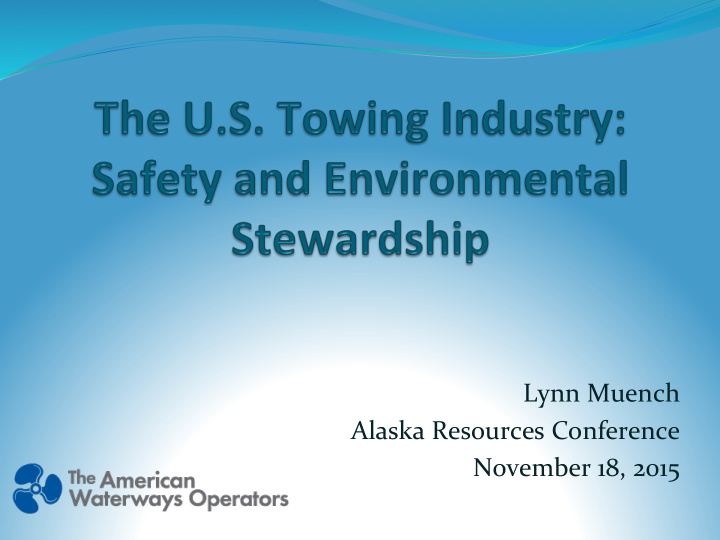



Lynn Muench Alaska Resources Conference November 18, 2015
Industry Overview Largest segment of the U.S. domestic fleet 5,000 tugboats and towboats 23,000 barges Geographically and operationally diverse 33,000 vessel crewmembers
AWO: The Industry Advocate 350 member companies Leader in marine safety and environmental stewardship Advocate with Congress, federal agencies and states Partner with and resource for government
AWO in Alaska 41,250 jobs $6 billion to Alaska’s economy Vital commodities Geographic range
Benefits of Water Transporta=on Volume & Economy of Scale • One 15-barge tow carries as much dry cargo as 216 rail cars or 1,050 trucks • One 30,000 bbl inland tank barge carries as much liquid cargo as 46 rail cars or 144 trucks Source: Texas Transportation Institute
Benefits of Water Transporta=on Fuel Efficiency & Environmental Protection • Barges travel farther on less fuel than rail or truck and produce fewer emissions per ton-mile Source: Texas Transportation Institute
Benefits of Water Transporta=on Public Safety Barge transportation • causes fewer fatalities than rail or truck Source: Texas Transportation Institute
AWO’s Founda=onal Commitment “Lead and support members in continuously improving safety, security and environmental stewardship.”
Posi=ve Safety Trends Level shifts downward in crew fatalities Tank barge oil spills at historic low levels Source: U.S. Coast Guard (CG-INV)
Scope of AWO Safety Ini=a=ves Future of AWO Safety Leadership Task Force Responsible Carrier Program Fatigue Prevention and Management Coast Guard-AWO Safety Partnership Interregion and Coastal Safety Committees
AWO Safety Leadership Vision AWO members, by creating strong safety cultures, will lead the industry in safety and environmental stewardship by: Exceeding regulatory minimums Striving for continuous improvement Measuring performance
AWO Responsible Carrier Program Safety management system for AWO members Independent, third-party audit Condition of membership since 2000 Evolving and improving Preliminary CG acceptance as TSMS
Why Safety Management Systems? Address the #1 cause of towing vessel casualties: human error Supported by industry and government alike Facilitates a company/industry-wide safety culture Scalable/Flexible
Fa=gue Preven=on and Management Coast Guard-AWO Safety Partnership focus Science-based approach Northwestern University research Transportation Research Board study Future vision
Coast Guard-AWO Safety Partnership First of its kind Non-regulatory focus Data-driven 40+ Quality Action Teams since 1995
AWO Safety CommiMees Forum for member company safety professionals Share lessons learned and promote continuous improvement Current focus areas: operational oil spills, distracted operations, RCP implementation
Subchapter M: Historic Change • Origins in Coast Guard- AWO Safety Partnership • Publication expected in 2016 • Builds on two decades of industry/government safety initiatives • Raises safety standards throughout industry • Safety Management Systems a key feature
Alaska-based Safety and Advocacy IMO Polar Code Bering Sea Port Access Route Study Alaska Towing Vessel Cold Weather and Ice Operation Quality Action Team Alternative Planning Criteria Cook Inlet Harbor Safety Committee
Other Public Policy Priori=es Robust support for Jones Act Basis for multi-billion dollar investment in fleet renewal Economic Security National Security Nationally consistent, operationally practicable regulations Vessel discharge regulatory reform (S. 373/H.R. 980) Uniform federal standards vs. state-by-state patchwork
Lynn Muench lmuench@americanwaterways.com
Recommend
More recommend